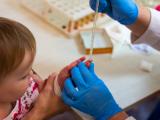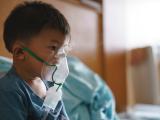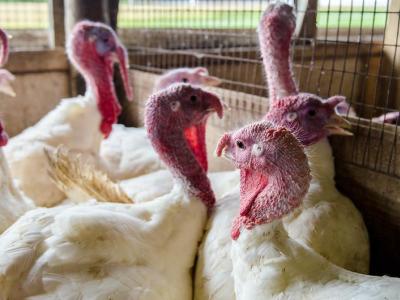Second in a series marking the 1-year anniversary of novel H1N1 pandemic influenza. The first, on the virus itself, appeared Apr 23.
Apr 26, 2010 (CIDRAP News) – Among the many surprises of the 2009 H1N1 flu pandemic—its emergence at the end of a flu season, its unexpected toll of mild illness, its almost-complete replacement of circulating seasonal strains—was its reversal of years of received wisdom on how vaccines would be needed to respond.
Researchers had predicted, for instance, that to be protected against a novel strain, most members of the population would require two doses of vaccine containing the new pandemic strain. And because that many doses of vaccine would stress the existing vaccine-manufacturing system, other researchers had predicted that the addition of dose-sparing adjuvants to the new vaccine would be crucial to stretch out scarce supplies of newly made antigen.
Neither turned out to be true.
To the great relief of health authorities, most members of the population turned out to need only one dose of the novel vaccine, though whether the youngest children needed two became a matter for international disagreement. And because that move freed up so many doses of antigen, the United States' long reluctance to test and license adjuvants used in flu vaccines in Europe did not become the bad bet that many flu experts had feared.
By September 2009, Australian researchers were reporting in the New England Journal of Medicine that—contrary to predictions—one dose of a 15-microgram vaccine made from the novel strain produced an acceptable immune response in 97% of adults who received it.
By November, the National Institute of Allergy and Infectious Diseases (NIAID) of the National Institutes of Health (NIH) was reporting that the single-dose regimen was equally protective for pregnant women, who were emerging as one of the groups at highest risk of serious complications from the novel virus.
But US health authorities continued to caution that children younger than 10, another group at higher risk for pandemic complications, should continue to receive two doses of the new vaccine, because only 55% of children in those age-groups had produced a protective immune response after one dose.
That recommendation brought the United States into conflict with the World Health Organization (WHO), which only 3 days earlier had recommended giving young children a single dose as a way of extending the vaccine to as many children as possible. When asked about the discrepancy, Dr. Thomas Frieden, director of the Centers for Disease Control and Prevention (CDC), said: "If the data show a difference, we will reconsider our recommendations. . . . We're sticking with what the [Advisory Committee on Immunization Practices] has recommended."
A second report by the same Australian group, published in late December, found an adequate immune response in infants and young children after one dose, but that finding did not change US policy.
Other long-held predictions, however, turned out to be all too accurate. The fragile egg-based manufacturing system for flu vaccine, which had gone without significant innovation for 50 years, proved inadequate to manufacturing the new vaccine. The newly isolated pandemic strain did not grow well in chicken eggs—something that also had happened in the past for seasonal vaccine strains—and the resulting slowdown in manufacturing and delivery strained public confidence and allowed anti-vaccine sentiment to build.
At the same time, long-recognized bottlenecks in flu-vaccine production, including lack of capacity in the post-manufacturing "fill and finish" step that puts vaccine into vials, slowed the industry's process for getting the new antigen out to the marketplace.
In mid-summer 2009, federal officials had predicted they would be able to release 120 million doses of novel vaccine by October, with millions more doses to follow each week. By mid-August, that prediction was scaled back to 45 million doses by mid-October. And on Oct. 21, Health and Human Services (HHS) Secretary Kathleen Sebelius was grilled by Congress regarding the slow start to vaccine delivery: Only 12.8 million doses had become available.
In testimony, Sebelius blamed both the new virus's slow growth in eggs, and also production problems on some new manufacturing lines. "We anticipate that number [of doses] growing exponentially as we move into the season," she said. By early November we're confident that vaccine will be far more widely available. There'll be enough vaccine so every American who wants to can be vaccinated."
But by the end of 2009, Americans who had urgently pursued the vaccine when it was supposed to be delivered had turned away from seeking it. By this February, the CDC said in April, 229 million doses of antigen had been ordered, about 162 million had been "fill-finished," about 126 million had been put into distribution, and somewhere between 81 and 91 million doses had been administered.
That accounting made it clear that some millions of doses—the CDC could not, by April 1, say how many—were likely to be discarded because they are subject to strict expiration dates once packaged. (The Washington Post estimated the amount of vaccine discarded could reach more than 71 million doses.)
In a speech last week, Sebelius called the overpromising of vaccine one of the pandemic's "teachable moments" for her department. "We wanted to make sure the American people knew what we knew when we knew it, but we raised expectations too high," she said. Sebelius did not, however, specify how HHS would alter its approach in the future.
But additional millions of doses that remain in bulk form may last long enough to be combined into next fall's seasonal vaccine, giving manufacturers a head start on that always-unpredictable process—provided the circulating virus does not mutate over the summer to make the retained antigen unusable.
"It is theoretically possible that some of that antigen could be the H1N1 component of a trivalent vaccine," Dr. Anne Schuchat, director of the CDC's National Center for Immunizations and Respiratory Diseases, said in a briefing April 1. "Plans around that particular decision are under discussion between the Department of Health and Human Services and the individual manufacturers."
See also:
Apr 23 CIDRAP News story "H1N1 LESSONS LEARNED: Pandemic underscored influenza's unpredictability"
Greenberg ME, Lai MH, Hartel GF, et al. Response to a monovalent 2009 influenza A (H1N1) vaccine. N Engl J Med 2009 Dec 17;361(25):2405-13 Epub 2009 Sep 10. [Full text]
Nov 2, 2009, NIAID statement "Initial results show pregnant women mount strong immune response to one dose of 2009 H1N1 flu vaccine"
Nov 2, 2009, NIAID statement "Updated results: In youngest children, a second dose of 2009 H1N1 influenza vaccine elicits robust immune response"
Oct 30, 2009, WHO Pandemic (H1N1) 2009 briefing note 14: "Experts advise WHO on pandemic vaccine policies and strategies" http://www.who.int/csr/disease/swineflu/notes/briefing_20091030/en/index.html
Nolan T, McVernon J, Skeljo M, et al. Immunogenicity of a monovalent 2009 influenza A(H1N1) vaccine in infants and children. JAMA 2010;303(1) Epub 2009 Dec 21 [Full text]
Aug 14, 2009, CIDRAP News story "http://www.cidrap.umn.edu/cidrap/content/influenza/swineflu/news/aug1409vaccine.html"
Oct 21, 2009, Senate Committee on Homeland Security and Governmental Affairs, "H1N1 flu: monitoring the nation's response" (includes Sebelius testimony).
Apr 1 CDC press briefing transcript

















